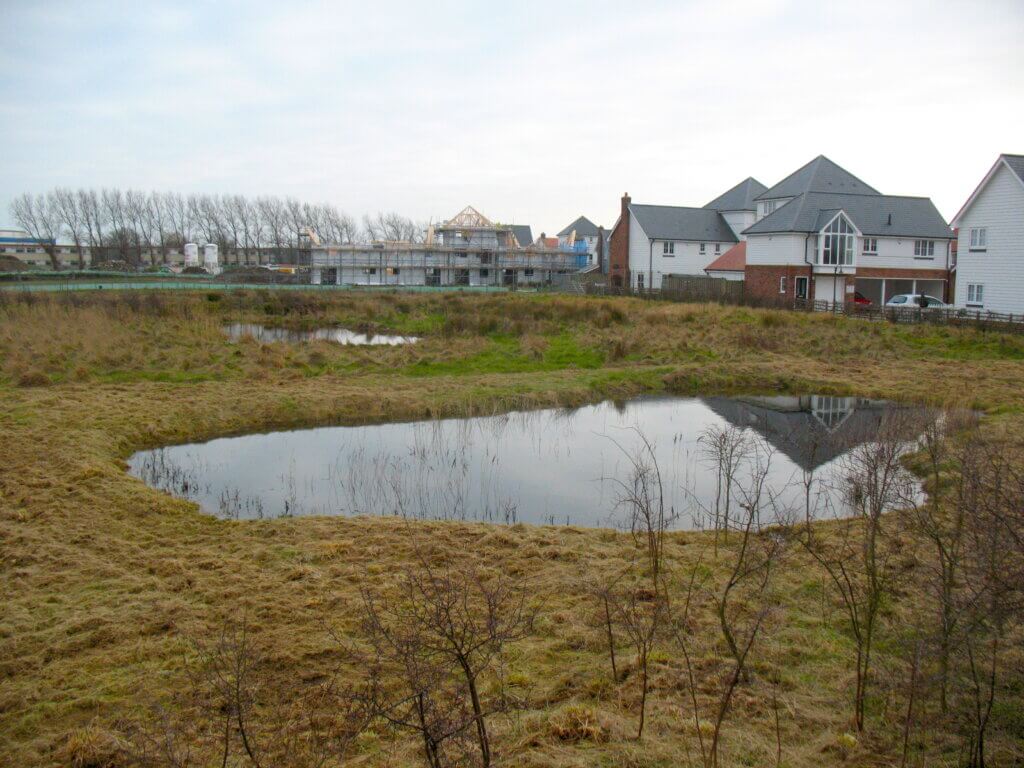 I am recently retired but have spent the last 20 years working as an ecologist, primarily in the conservation of our native reptile and amphibian species.
I am recently retired but have spent the last 20 years working as an ecologist, primarily in the conservation of our native reptile and amphibian species.
During this time I had to deal with many housing developers and the message I and other ecologists were always trying to get across was that our biodiversity was in crisis and therefore there was a need for developers to comply with the various wildlife legislation that protects the most threatened species.
barrykemp247@gmail.com
For many years now Great Crested Newts have been blamed for the lack of new house building and in recent years the legislation which protects them has been gradually watered down.

One scheme prompted by the Conservative government, and adopted by Natural England, known as District Level Licensing (DLL) provides developers with a licence allowing them to kill or injure newts in exchange for a contribution to enhance or create ponds elsewhere. The theory being that newts will colonise the new ponds despite the local population being reduced, or lost completely.
The message that English Nature seem to be sending out to developers is that it’s OK to kill newts.
The UK and European legislation which currently protects our threatened wildlife is complex and many aspects of the legislation have been interpreted in a way that has not always been to the benefit of the species.
However legislation is necessary to preserve the UK’s dwindling wildlife – goodwill to newts is not an attribute of most housing developers.
This message was repeated recently by Rachel Reeve’s comment that “Developers will no longer have to worry about bats and newts”.
The housing crisis is not caused by newts or bats, or any other legally protected species.
For a very large section of the population – and particularly first time buyers, house prices are now unaffordable. House builders are able to maximise their profits by building 4-bedroomed homes instead of the small, terraced houses that used to be built. By land banking and releasing new housing stock slowly into the market they have been able to maintain a high selling price.
Of the approximately 2.7 million residential units have been granted planning permission since 2015 only around 1.5 million have actually been built – click here.
Social housing stock has been sold off with no replacements being built. Increasingly houses and flats are being used as Air B &B’s or left empty for most of the year as second homes, private rents are at an all-time high and slum landlords remain largely unchallenged.
Even if these issues are resolved, currently there are not enough people working in the construction trades (especially since Brexit) to build housing on the scale that the government is promoting.
The government’s promise to speed up planning decisions seems unrealistic since the process relies on multiple input from a range of specialist consultees from within the local planning authority. Drainage, highways, water and waste, archaeological and ecological issues all have to be considered by the council – and these positions are under-staffed in most planning authorities.
Despite these issues in the year ending March 2024, UK planning authorities granted 86% of all applications – click here . So it’s difficult to see how newts and bats are having the affect this (and previous governments) are claiming.

In fact in most situations where protected species occur on a development site this does not stop a development but merely results in a mitigation scheme (such as DLL) and these have varying degrees of benefit to the species.
The recent State of Nature Report – click here – concluded that the UK is one of the most nature depleted countries in the world, with roughly only half its biodiversity still remaining. Research undertaken by the Natural History Museum found the UK is the worst among the G7 group for Biodiversity Intactness – click here – and in the bottom 10% of the 240 nations globally.
We are meant to be a nation of animal lovers – so how did we allow things to get so bad?
[registration_form]
Good to see that this issue has been raised on Mark’s blog – it is probably one of the most significant issues affecting nature conservation in England since an event that was held in June 2016.
For those who are interested in the genesis of Barry’s narrative, it is this rather vague and verbose Working Paper: https://www.gov.uk/government/publications/planning-reform-working-paper-development-and-nature-recovery/planning-reform-working-paper-development-and-nature-recovery.
If you are interested in an erudite response, see https://cieem.net/cieem-responds-to-governments-planning-reform-working-paper-on-development-and-nature-recovery-in-england/
In the Working Paper, the Government are suggesting that they are seriously considering the proposition of ridding developers of that most annoying of procedures, ecological due diligence. In other words, no pre-planning application ecology surveys. What Barry didn’t mention that this is not restricted to protected species such as newts or bats. But any site; all biodiversity. Anywhere in England.
Instead, the Government are saying that the developer will pay a levy (not a tax, a levy) to Natural England, who will then be tasked with spending that money enhancing a piece of land somewhere else. There is no detail as to what informs the value of this levy (the current assumption is that it will be a guess or related to land area), nor how this will improve the other piece of land such that whatever is lost can be reclaimed/ regenerated elsewhere. So if the development plot had, say a rare assemblage of flowers, a much loved piece of greenspace supporting locally important populations of garden birds, a few orchids; these can all be sacrificed by way of a payment to Natural England, who would then, despite not having any resources to do so, enhance another plot of land. There is no indication how the fauna and flora would jump the temporal gap, i.e. the time between the development destroying their habitat and the new site, if it ever materialised, would occur. The new development would, in affect, be sterilised and any recruitment post-construction would be dependent on its connectivity to other greenspace.
And why is this happening?
Well, it is ostensibly because the Labour Government consider that biodiversity, framed under the narrative of bats and newts, delays development and any ecology survey is blocking such activity. This is pure, inverted pyramids of piffle (to quote a previous PM). But it is not new. Way back, in the dim and distant past, sometime in the mid-2000s, a Labour Chancellor, the late Alistair Darling, had a similar ‘moment’ and commissioned a Review, what became the Davidson Review (see https://www.regulation.org.uk/library/2006_davidson_review.pdf). The Brief was to determine to what extent EU legislation was being gold-plated in the UK. A QC (no less) reported back (no guesses as to his surname) that the extent to which EU law was being gold-placed was, in one word, negligible. Indeed, the Review reported that the regulatory framework was one of the most favourable for doing business in the EU.
Since this Review, there have been many others, I won’t repeat all of them here but they occur with frequency and are mentioned in CIEEM’s response I linked to at the beginning of this comment. They have all reported that the regulatory framework that protects nature and its integration with the planning system works well. There are always the odd project that causes a problem; but that is the way of the world. Nothing is perfect.
So are there delays? Absolutely there are. Removing the scenarios where developers don’t engage ecologists until a long way down a project’s progression, delays are encountered because of the lack of resources in Local Planning Authorities (LPA) – e.g. just under 60% employed a skilled ecologist (see https://www.adeptnet.org.uk/sites/default/files/media/2022-07/ALGE-ADEPT%20Report%20on%20LPAs%20and%20BNG.pdf). Most LPAs also lack resources in planning teams. So delays are inevitable because the incoming volume of work is at a rate that is higher than the decision maker can make a robust decision.
Of course, planning applications are not just about newts, bats and other wildlife; there are issues around drainage, contamination, ground conditions, hydrology highways, utilities, cultural heritage, landscape, sustainability, resources, schools, commerce and so on to record, design and assess; before applying the mitigation hierarchy. Yet one never hears about engineers delaying development; or the challenges and time-consuming activities around contaminated land (you cannot translocate toxic soil) causing unnecessary infringements on economic growth.
And talking about growth, the Environmental and Sustainable consultancy sector employs at least 20K in England and the Environment Analyst website (https://environment-analyst.com/uk/) reported:
———————————————–
In August Environment Analyst published its annual UK Environment & Sustainability (E&S)Consulting Market Assessment report, assessing market trends for the financial year2021/2022. The report reveals that the E&S consulting sector grew a remarkable 48.1% to a market value of £2.9bn in 2022. Further growth of 12.1% is predicted in the following year and a forecasted total market value of £4.9bn is expected by 2027.
Several drivers are behind this expansion. The end of pandemic restrictions gave way to a surge in demand for climate change and energy, sustainability and ESG strategies, ecology and biodiversity, and water quality services. Momentum in corporate reporting legislation, the net zero agenda, and the energy transition called for more E&S consulting services, leading top consultancies to achieve an average annual growth of 37.7% in their E&S revenues. The analysis also found that many large companies are repositioning some existing consulting service areas to meet the increasing demand for E&S consulting.
——————————————————————————-
Now that is what I’d call growth. Which begs the question, why is Labour looking to torpedo this sector with potentially thousands of redundancies of highly skilled, motivated and passionate individuals?
Many of us are writing to our MPs, in response to this Working Paper. You may dislike the houses being proposed on that greenspace near you; or indeed welcome the news if that means your son, daughter or other family member can buy a property. But be assured that up to now, ecologists have (by and large) looked to deliver the best possible outcome within the legal and policy framework available to them. All of that is being threatened; and I am struggling to believe that it is a Labour Government doing so. It is Trumpian in nature and Trumpian in action. They are literally seeking to bulldoze their way through decades of environmental legislation and case-law in pursuit of an end outcome of 1.5M housing that will almost certainly fail; not because of newts, bats, or even a dormouse or three; but due to a lack of human resources – to make the decisions. And as the Letwin Review identified in 2019 (see paragraphs 1.9 to 1.11: https://assets.publishing.service.gov.uk/media/5bd6eb3940f0b6051e77b6a6/Letwin_review_web_version.pdf) – a lack of skilled labour.
That is where the Labour Government should be seeking to address the delays; not attacking, yet again, the concept that nature and the economy are at odds with each other. You won’t be surprised there is a Review that looked at this very issue – the Dasgupta Review – https://www.gov.uk/government/publications/final-report-the-economics-of-biodiversity-the-dasgupta-review – and you equally won’t be surprised to read that the findings were, in summary that the economy needs the natural world.
I have no idea where all of this is going to end up – the forthcoming Infrastructure and Planning Bill will likely reveal whether the responses submitted by various organisations and learned societies will have had influence. And I will learn whether, after 25 years, I have a career left.
As H L Mencken once said “For every complex problem there is an answer that is clear, simple and wrong.” The idea that ‘gold-plated’ regulations protecting bats and newts are the reason why Britain has failed to build sufficient houses to meet estimated needs is a perfect example of this. Unfortunately both politicians and voters love simplistic solutions to complex problems as we see perhaps most starkly at the moment when we gaze across the Atlantic.
I have written to my MP about this and shall do so again but I fear that along with the many others who share these concerns, I will be dismissed as a ‘blocker’.
In any case, thank you for your clear and detailed exposition of the background to this issue.
Yes! And the housing industry is one of the largest doners to both the conservative and labour parties!
Somewhere I read a study that said at least 1 million homes (houses and flats) are standing empty. In addition there are a great many older buildings which are unused and could be restored as flats.
And don’t forget the historic, aesthetic, and emotional ties we all have to nature AND to our built environment. Both are being destroyed.
Well said Barry. Reeves and Starmer are just the latest in a long line of politicians who have sought to scapegoat newts and bats for the failures of the house-building industry and governments to provide the numbers of new houses needed. It is deeply frustrating.
Wild Justice commissioned a report on the degree of compliance that developers have made in their Biodiversity Net Gain commitments when developing a site (https://wildjustice.org.uk/general/lost-nature-report/). It is a sobering read.
The University of Sheffield will be following this up and will be trying to get more people trained and involved in monitoring many more recent developments to see if they are keeping their word about the mitigations they have said they would be putting in place when developing a site.